
Learning to learn in English
.pdf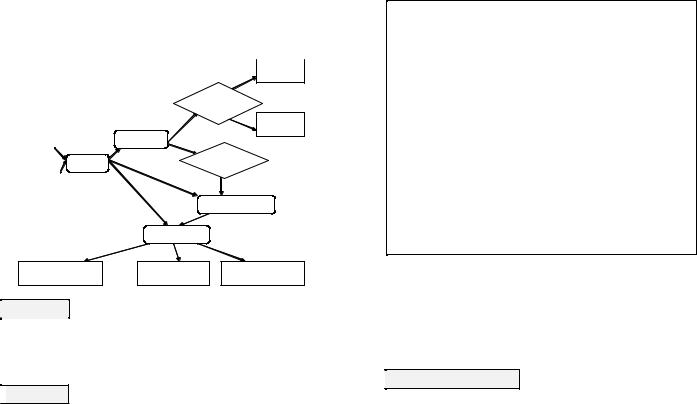
used computer equipment, particularly for its scrap metal value, which recently has been quite high.
(Adapted from the Internet sites)
How E-Waste Recycling Works
repairable products
businesses |
|
refurbishers |
|
|
|
|
|
|
|
|
|
demanufacturers
lead
 Get real
Get real
Search home pages of the leading computer companies and environment websites to get more information on possible solutions to e-waste problem. Report back to the class and discuss what you have found.

 Writing
Writing
You are planning to buy a new computer but don’t know what to do with the old one. Write an e-mail message to one of the electronic equipment manufacturersaskingfor the informationonthe company’stakeback policies.
From:
To:
Subject: Old computer treatment
Dear Sir/Madam,
I am mailing this via the “Contact Us” link on your website to (1) ………………
….………………………………………………………………………………………
………………………………………………………………………………………... . Ibought myold PC (2) …………………………………………………………….
………………………………………………………………………………………….
………………………………………………………………………………………….
………………………………………………………………………………………... . Could you give me more information about (3)…………………………………….
………………………………………………………………………………………….
………………………………………………………………………………………... . Ihope you will (4)…………………………………………………………………
Ilook forward to hearing from you soon.
Yours faithfully,
(5)……………………
(1)explain the purpose of your e-mail
(2)provide basic information on your PC and its components, when and where you bought it, decide whether they are still working or not
(3)ask for information on the items the company takes back, delivery, package and prices
(4)express your gratitude for the help
(5)sign the letter
 In the Realm of Science
In the Realm of Science
1.Check the meaning of the words below. Which of them are chemical elements? Which are compounds? Write down the symbols for the elements and formulae for the compounds.
160 |
161 |

nitric acid |
cadmium |
dioxide |
nitrogen oxide |
calcium |
phosphine |
hydrochloric acid |
mercury |
sulphur |
hydrocarbons |
carbon dioxide |
|
2.Work in pairs. Take turns to read and note down these elements and compounds:
StudentA: |
Si |
N |
P |
C |
Cd |
Al |
Student B: |
S |
H |
O |
Na |
Li |
Zn |
3.Read the song “The Elements” by Tom Lehrer. Do you know equivalents in your native language to the elements named in the song?
There’s antimony, arsenic, aluminum, selenium, And hydrogen and oxygen and nitrogen and rhenium And nickel, neodymium, neptunium, germanium, And iron, americium, ruthenium, uranium, Europium, zirconium, lutetium, vanadium
And lanthanum and osmium and astatine and radium And gold, protactinium and indium and gallium And iodine and thorium and thulium and thallium.
There’s yttrium, ytterbium, actinium, rubidium And boron, gadolinium, niobium, iridium
And strontium and silicon and silver and samarium, And bismuth, bromine, lithium, beryllium and barium. There’s holmium and helium and hafnium and erbium And phosphorous and francium and fluorine and terbium And manganese and mercury, molybdinum, magnesium,
Dysprosium and scandium and cerium and cesium And lead, praseodymium, platinum, plutonium, Palladium, promethium, potassium, polonium, Tantalum, technetium, titanium, tellurium,
And cadmium and calcium and chromium and curium. There’s sulfur, californium and fermium, berkelium And also mendelevium, einsteinium and nobelium And argon, krypton, neon, radon, xenon, zinc and rhodium
And chlorine, cobalt, carbon, copper, Tungsten, tin and sodium.
These are the only ones of which the news has come to Harvard, And there may be many others but they haven’t been discovered.
(Listen to it at http://school.discovery.com/lessonplans/activities/sciencehits/)
Unit 2 Progress Monitoring
In this unit you have worked on the following vocabulary related to the topic “Negative influence of electronic equipment on the environment”
|
environmental hazards |
|
to consume energy |
|
landfill/damp sites |
|
to release poisonous gases |
|
incineration |
|
to encourage/to urge e-recycling |
|
disposal of electronic equipment |
|
to donate/to reuse electronic equipment |
|
to produce/to generate e-waste |
|
to reduce/to limit computer dumping |
|
liquid |
|
to refurbish/to restore/to repair |
|
to be short of |
|
e-devices |
|
environmentally friendly/safe |
|
to recycle e-waste/industrial waste |
|
to use up natural resources |
|
to increase/decrease the amount of |
|
a compound |
|
harmful chemical substances |
Tick(V) thepoints youareconfidentaboutandcross (X) the onesyouneed torevise.
162 |
163 |
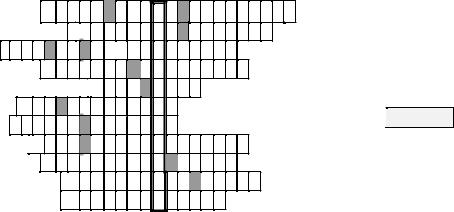
Unit 3 |
Revise & Practise |
|
|
1. Explain the difference between these pairs. |
|
||
|
litter |
– |
waste |
|
break down |
– |
dismantle |
|
refurbish |
– |
repair |
|
recycle |
– |
process |
|
effect |
– |
affect |
|
chemical element |
– |
chemical compound |
2.Write downa short vocabularylist (10 items) onthe topic “Environment”. Compare your lists. Crossout the items youhave onboth listsand explain the meaning of the rest of the words and phrases.
3.Do the crossword to write the word in bold.
1
2 
3
4
 5
5
6
7
 8
8
9
10
11
1)the reduction of the layer of natural gases around the earth that protects people, animals, etc. from dangerous ultraviolet radiation;
2)the reductionof the territory that a plant or animal lives and grows best in;
3)a process when different species which make a balanced environment disappear;
4)floods, volcanic eruptionsand hurricanes, etc. that cause a lot ofdamage;
5)a result ofatmospheric contaminationwhen industrial gasesand chemicals mix with water in the air;
6)harmful chemicals and gases from factories, traffic fumes that enter the air to make it dirty;
7)a general increase in the temperature of the world caused by harmful chemicals and gases;
8)harmful chemicals, waste materialsfrom factories, houses etc. that enter the land and kill or damage the things that live or grow there;
9)gasesfromfactories, machines, traffic fumesetc. that forma layer around the earth;
10)devices and/or their components that are no longer useful;
11)a process when too many trees are cut down in an area, so that the environment is badly damaged.
4.Read these sayings. Comment on the one you like most.
“The nation that destroys itssoil destroysitself.” Franklin D. Roosevelt
“Modern technology owes ecology an apology.” Alan M. Eddison
“We do not inherit the earth from our ancestors, we borrow it from our children.” Native American Proverb
“If civilization has risen from the Stone Age, it can rise again from
the Wastepaper Age.” Jacques Barzun, The House of Intellect
 Case study
Case study
All of you are at the meeting which is held to discuss the most urgent environmental problems in your city. Each student plays one of the roles described below. Read the situation and the role descriptions and decide who will play each role. Divide into 5 groups (group A – environmentalists, B – bank representatives, C – city residents, D – city council members, E – project managers). Make use of the language for debating in the Tool box.
The situation
The World Bank has decided to fund the “Eco-friendly city” programme. As the representatives of different local organizations and the community you
164 |
165 |

have to discuss the most urgent environmental problems in your city, the ways to solve them and to work out projects that will allow to cope with the most urgent problems in your neighborhood.Asa result theWorld Bank will choose the most attractive project.
Roles: project manager
Youliveinthiscityandworkinthelocalbranch of the World Bank. The Board of Trustees appointed you to be the person in charge for thesuccessful realizationofthe eco-programme in your city. You introduce the programme of the World Bank, briefly describe the situation and conduct the meeting.
Roles: environmentalists
You are a member of the local Green Peace organization. You are concerned with the high
level of industrial waste, soil and water contamination in your city. Present your project and suggest the ways for its realization.
Roles: city residents
You are worried about the shrinking of green spaces and increasing of air pollution in your city. Present your project and suggest ways and terms of its realization.
Roles: the City council member
The City council is concerned with the poor quality treatment of sewage waters. Present your project and suggest ways and terms of its realization.
Roles: The World Bank representative
You are a member of the World Bank Board of Trustees who is responsible for choosing the most attractive project and an appropriate use of the money donated. Choose the best project and explain your reasons.
Progress Test
1. Join the sentences in two ways, with or without which/that.
a)A lot of rubbish is floating in the sea. It is a real danger to health. b)The problem of soil erosion is discussed in this chapter. It has
occurred ever since the man began destroy forests.
c)Nuclear energy comes from the energy stored within the nuclei of atoms. They are the basic building blocks of all matter.
d)The best things in life such as water and air are free. We often take it for granted.
e)The manufacture of one PC requires 28kg of liquid chemicals. All liquid chemicals have to be neutralized by a further 11 kg of sodium hydroxide.
f)An average PC consumes 100 watts of electricity when switched on but not in use. 100 watts of electricity is equivalent to a bright light bulb. g)New machines use no more than 30 watts. They are given the Energy
Star Logo.
h)In1993theUSAintroducedtheEnergyStarLogo.TheESLeliminated the need to build 10 extra power stations.
i)In the USA computers use 5 % of commercial power. By 2010 the use of commercial power by computers could rise to 15 %, or 100 billion kilowatt-hours per year.
j)Some factories had developed manufacturing processes. This processes considerably cut the amount of wastes produced.
2.Join the sentences with to, in order (not) to, so that or for.
a)European countries formed a work group. The purpose of the work group is to work out the measures that will limit computer dumping.
b)Old computers can be used in schools and colleges. They must be dismantled and adapted.
c) Manufacturers are encouraged to make a lot of changes to their products. New products need to be more easily recycled.
d)Hewlett-Packard takes back old computers, faxes, printers, etc. It disassembles the office equipment, reconditions its components.
e)Hewlett-Packard disassembles old computing equipment, reconditions its subassemblies. They are used as spare parts for customer’s existing equipment.
f)Manufacturers spend a lot of time and money for various retraining programmes. They need to retrain designers, engineers and assembly workers to perform environmentally friendly computer design and manufacturing.
166 |
167 |
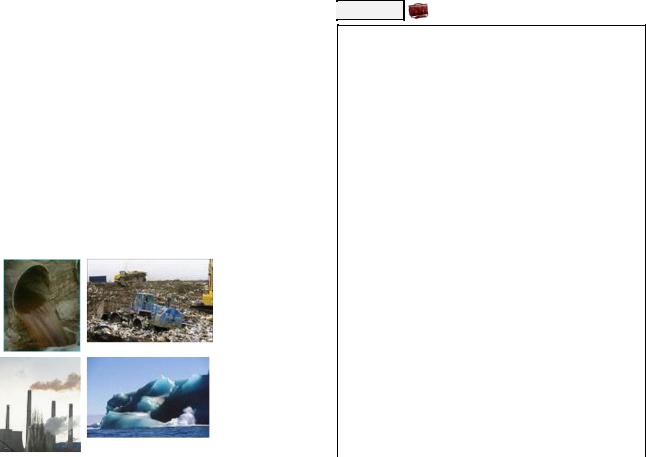
3. Complete the sentences using the most suitable adverb from the box.
unusually |
confidently |
absolutely |
highly |
badly |
quickly |
well (х2) |
safely |
|
|
|
|
a) I can’t think ……… when I’m in a hurry or upset about something. b)This year spring is going to be……… hot in this region.
c) These are ………reliable statistics on industrial waste for the last five years.
d)I wanted to increase the pressure in the apparatus but I wasn’t sure if I could do it ……….
e)Though I was very nervous I tried to speak ……….
f)This ……… operating machine for producing hamburgers is a real
wander!
g)What we need is a ……… equipped laboratory and ………
enthusiastic specialists.
h)Nick feels so homesick, he ……… misses his parent and friends.
4.Look at the pictures and with a partner discuss the environmental problems theyillustrate.Write aparagraphofabout 150wordstodescribe thepicture
you have chosen.
168
 Self study
Self study
Does one soldier make a battle?
The state of the environment today has reached a crisis point. This crisis stems largely from humankind’s attempts at “development” – that is, our efforts to make our lives more sophisticated, more comfortable and more satisfying. . We have misused and polluted the planet out of self interest.
Therangeof theworld’s environmental problemsis so wide and theconsequences are so devastatingthat it is hard to believethat any action by one person or small community will make any difference. Buе the ancient Chinese proverb says that a journey of a thousand miles begins with a single step. It is time to take this step, explore the facts, discuss theissues and share your thoughts.Search thesite Planet Under Pressure http://news.bbc.co.uk/2/hi/in_depth/sci_tech/2004/planet/default.stm
THE QUESTIONS AND TASKS TO GUIDE YOU:
Intoduction
Read the introductory article to the series of the six environmental issues facing the human race today: food, energy, water, climate change, biodiversity and pollution.
Why these areas have been chosen for the series?
Choose one part, study the article, graphs, photos; do the quiz; read people
comments and summarize the main points in a diagrammic way.
Animated guide
How much will the Earth warm by 2100?
Study the diagrams describing the sources of greenhouse effect and its influence on glaciers and Gulf Streem.
Kyoto era dawns
What measures does the international community take to ease greenhouse gas emissions pressure?
What is the Kyoto protocol aimed at?
How many greenhouse gases are covered by the Kyoto protocol?
Which European countries signed the agreement?
How has the world changed under the effect of human activity?
Look at the photos by Gary Braasch. Which pair of pictures impressed you most? Why?
Changing world
Look at the photos of environmental change around the world. Take photos in your city/town illustrating this change and supplement the photos with captions explaining the change.
169
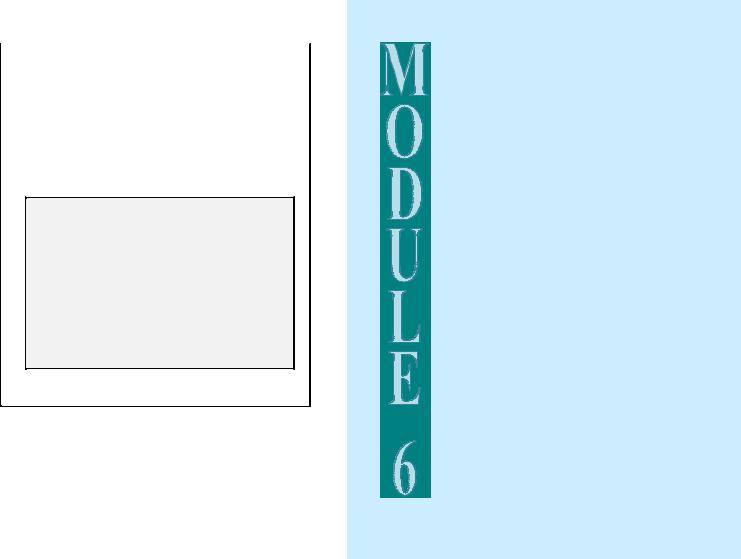
Talking Point
Listen to or watch a phone-in programme on climate change.
What are the priorities for world’s leaders to combat climate change?
Read a selection of comments and write an e-mail sharing your thoughts on the point.
Green gardening
Where according to the Planet Under Pressure series can the first steps toward solving environmental issues begin?
What kind of competition was held at the project?
Saving the planet
Read teenager’s ideas on how they would tackle environmental damage. Choose two of them and comment on them.
Managing your learning
Diagrams have the potential to capture a lot of information on a single page. They help to show the conceptual links between ideas and allow to add additional material without the need to crowd the page.
While drawing diagrams
-use lines, colours, branches, arrows or some other ways of showing connections between ideas;
-leave lots of space to highlight things, add information or add questions and words;
-write down key ideas in capitals as they are easier to read in a diagram and explanatory notes in lower case.
NB! All the task must be completed in a written form and test results printed out, photos enclosed.
SCIENCE FRONTIERS
“The future is always beginning now”
Mark Strand
Learning Goals
to organize information in a timeline
to use timelines and time/sequence expressions for narrating and reporting
to write a summary of articles and reports
to learn how to show relationships between ideas
to talk about the latest and perspective achievements in science
to revisit Future Tenses
170
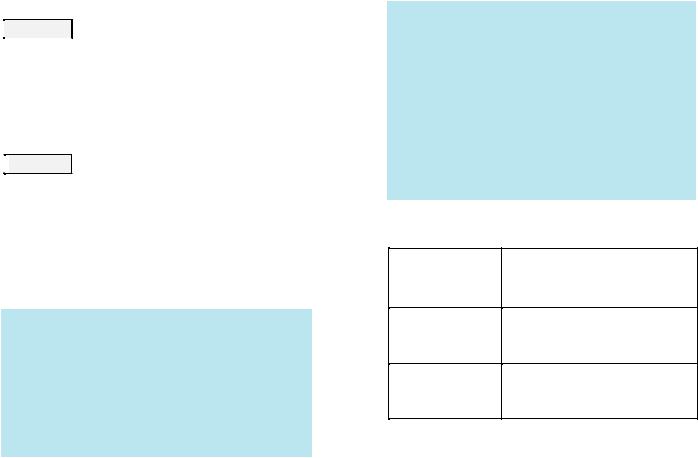
Unit 1 |
The 20th Century and Beyond |
 Lead-in
Lead-in
1.What are the greatest achievements in major fields of science in recent 50 years? And what are the challenges?
2.Work with a partner. Come up with 3 most important scientific or technological innovations for the last decade. Have any of these innovations affected you personally?
3.Name the modern inventions for the last 50 years you could not live without?

 Reading
Reading
1.Read the introductory part to the report at the UNESCO/ICSU World Conference on Science (WCS) below and answer the questions.
a)What kind of discoveries does the author focus on?
b)What have been the unforeseen consequences of advances in science?
c)How do the authors prove that “science finds itself in a challenging situation”?
d)According to the report what is the greatest achievement in the 20th century?
e)Are the authors optimistic about science in future?
Science for the Twenty-First Century
By Paul Hoyningen-Huene, Marcel Weber, Eric Oberheim
The second half of the 20th century has witnessed a great number of scientific discoveries and technological innovations which have had, and continue to have, the greatest impact on humanity and are frequently closely interconnected. The origins of theuniverse, the evolution oflife on Earth, thestructureand function of biomolecules and many natural phenomena, ranging from the subatomic to the cosmic
scale, are farbetter understood todaythan they were 50 years ago.
At the same time, the progress that scientistshavemadehasprovidedunforeseen power, which enables us to change our lives, our world, as well as our future. On the other hand, this power can also have negative consequences. It is a factor that has contributed to the damage to the Earth’s natural environments and it has
172
been used to construct weapons of mass destruction– remindingus that with power comes the responsibility to use it wisely.
At thedawn of the 21st century, science findsitselfin achallengingsituation.Today, there are more professionally trained scientists than in all previous generations combined together. At the same time humankind’s most pressing challenges such as food supply, public health, global climate change, or the protection of biodiversity seem to escalate. So, there is a need in combined scientists’efforts. The globalization of markets, production, and finances may lead to a shift from national research and development priorities towards a world-wide network of research activities.
Apart from largescale research programmes which require international cooperation, scientific research which provides little or no short-term economic profit may be called into question.
The twentieth century saw more momentous change than any previous century:changeforbetter,changeforworse; change that either brought enormous benefits to human beings or threatens the veryexistence ofthe human species. Many factors contributed to this change but the key factor was the progress in science.
Nevertheless,inthenext50 yearsscience will continueto surpriseus both with what it discovers and creates.
(“Science for the Twenty-First Century: A New Commitment”)
2.Now work in groups of three. Each student in a group reads one of the texts (A, B or C) and completes the table.
1 field of science
2achievements
3practical application
(comments)
173

|
|
Mathematics differs from the other sciencesin that its subject is notnature. |
|
|
Progress in mathematics is usuallynot directlyrealized by thepublicsinceits |
A |
|
results are so abstract and often isolated from everyday experience that they |
|
are difficult to understand. However, occasionally some mathematical news |
|
Text |
|
|
|
becomes visible to a broader public. One example is the application of large |
|
|
|
prime numbers for encryption purposes. Sometimes a result in pure |
|
|
mathematics also catches public attention like the recent proof of Fermat’s |
|
|
last theorem, which resisted the best efforts of mathematicians for more than |
|
|
threeand ahalf centuries. |
|
|
But mathematics is more than just peculiar theorems and occasional |
|
|
popular achievements. Because of its precision and accuracy, it is an |
|
|
essential tool for all of the sciences. There are many examples from the |
|
|
history of science in which the development of new mathematical |
|
|
methods allowed scientists to formulate fundamentally new theories and |
|
|
to achieve revolutionary conceptual breakthroughs. One of the most |
|
|
spectacular cases in this century was Einstein's use of the non-Euclidian |
|
|
geometry developed by Riemann in the 19th century to formulate the |
|
|
general theory of relativity. |
|
|
The last part of the 20th century has seen spectacular advances in |
|
|
mathematics, especially in the theory of dynamical systems and in stochastic |
|
|
analysis*. A combination of analytical and geometrical ideas has been |
|
|
characteristic of these developments. One example is the use of diffusion- |
|
|
reaction equations* to understand biological pattern formation*. Another |
|
|
example is the advances in our understanding of turbulence, in particular in |
|
|
thecontextof weather forecasting. |
|
|
At mid-century, mathematics was examining its own foundations. Today |
|
|
we see a different trend, which is strongly influenced by recent advances in |
|
|
computing technology. Mathematical modelling, the development of |
|
|
algorithms, and scientific computing have become powerful tools for all the |
|
|
sciences. Theypromise toplay acrucial rolein futureprogress. |
*stochasticanalysis–вероятностный анализ.
*diffusion-reaction equations– уравнениереакции диффузии.
*biological pattern formation – образование биологического рисунка.
|
|
The chemical sciences have made breathtaking advances during the last |
|
|
five decades. They have provided innumerable benefits through an extremely |
B |
|
wide range of applications. These include not only new materials, food |
|
additives, pharmaceuticals, and pesticides, but also new analytical tools |
|
Text |
|
|
|
for the study of living matter as well as the environment. The structures of |
|
|
|
many molecules were determined and this has provided the basis for their |
|
|
synthesis and production on an industrial scale. Notable examples are |
|
|
vitamins, which complement many biochemical reactions in the human |
|
|
body, and antibiotics, which have saved many lives. |
|
|
In addition to characterising and synthesising a vast number of natural |
|
|
products, chemists have also designed absolutely new compounds. Major |
|
174 |
|
progress was also made in the synthesis of tailor-made polymers*, composite materials, and ceramics which is capable of superconduction.
Organic chemistry was instrumental to the great advances in understanding the structure and function of biomolecules. This has had an enormous impact on the biomedical sciences. For instance, in 1954, the first naturally occurring protein hormone was analysed and then synthesised. For the first time, it was shown that an artificially produced protein has exactly the same properties as those naturally produced. The synthesis of insulin, a life-saving protein for diabetics, followed shortly thereafter. In 1959, the three-dimensional structure of haemoglobin (the oxygen-transporting molecule that makes blood red) was determined at atomic resolution*. Since then, the structures of thousands of biologically important molecules have been described. This knowledge plays a vital role in the development of new diagnostics and therapeutics. Aided by fast computers, medicinal chemists increasingly use the knowledge of biomolecular structures to design small compounds with very specific pharmacological properties and make significant contributions both to our understanding of life processes and to medicine.
The chemical sciences are also contributing to the environmental sciences. For example, they providenew materials and contributeto thedevelopmentof new means to cropprotection, as well as animal and human health.
*tailor-madepolymers–полимерысзаданными свойствами.
*at atomic resolution – на уровне атомов.
|
|
|
Overthelast fifty years, ourown solarsystem and its origins have become |
|
C |
|
|
much better known. Many new satellites and rings around planets have been |
|
|
|
discovered and the nature of comets has been disclosed. One of the main |
|
|
Text |
|
|
|
|
|
|
reasons for this development was thebeginningofthespaceage. All of these |
|
|
|
|
|
innovations were made possible by new observation instruments. Fifty years |
|
|
|
|
ago, the largest telescope was a 5-metre optical telescope, whereas modern |
|
|
|
|
telescopes are four times larger and more powerful. Furthermore, in 1990, |
|
|
|
|
the Hubble space telescope was sent into orbit. It has provided a lot of new |
|
|
|
|
information about our universe, as the radiation it collects does not have to |
|
|
|
|
pass through theEarth's atmosphere. |
|
|
|
|
From the early 1960s on, communication satellites were sent into orbit, |
|
|
|
|
making wireless communication possible all around the world. Landings on |
|
|
|
|
the Moon and the planets by probes of ever increasing sophistication started |
|
|
|
|
in the mid-1960s and continue today. Some of them have brought back |
|
|
|
|
samples making an in-depth chemical analysis of their composition |
|
|
|
|
possible. In 1969, the first man set foot on the moon, only twelve years |
|
|
|
|
after the first satellite was launched. |
|
|
|
|
Another example is the development of weather satellites, which have |
|
|
|
|
become indispensable for tracking hurricanes and other violent storms. |
|
|
175 |
|
||
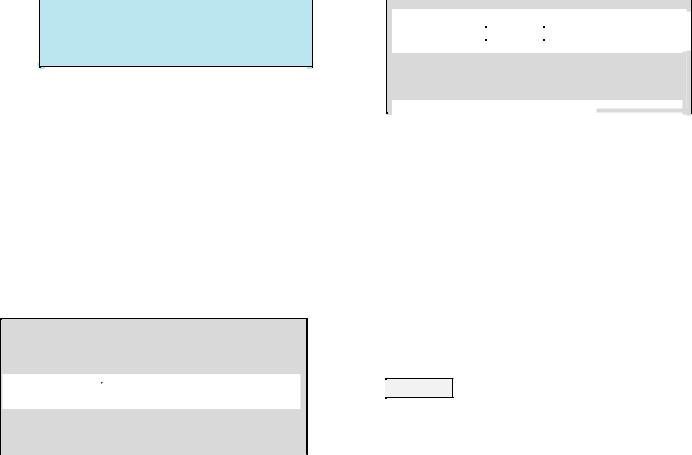
While these storms are still potentially dangerous, timely warning of their approach has saved many lives and helped to avoid vast property damage. Another example is the Earth resource satellites, which have become an integral part of geological data collection and provide us with a better means of assessing the Earth's resources. In addition, these satellites supply information about forest growth and crop diseases*.
*cropdiseases– заболеваниясельскохозяйственных культур
(Adapted from “Science for the Twenty-First Century:A New Commitment”)
3.Now exchange the information with the other students in your group to list all the achievements mentioned in texts A, B and C.
4.Look back inthe textsand find 9 adjectivesthat are similar inmeaning to the word important. Check in the dictionary the difference in their meanings.
Focus on language
1.Read the sentences and determine the relationships between the parts in each sentence.
Innumerable benefits include not only new materials and food additives,butalsonewanalyticaltoolsforthestudyoflivingmatter.
The scientists have made the progress that has provided unforeseen power, which enables us to change our lives, our world as well as our future.
Because of its precision, mathematics is an essential tool for all of
the sciences.
Showing relationships between ideas
To connect words and phrases that have the same grammatical function in a sentence we use conjunctions, prepositions and adverbs.
conjunctions*
e.g.: The twentieth century saw much momentous change that either brought enormous benefits to human beings, or threatens the very existence of the human species.
Both … and … |
when connects two subjects require plural verb |
Not only … but also … |
when connects two subjects, the latter determines whether |
Either … or … |
the verb is singular or plural |
Neither … nor … |
|
*The same grammatical form should follow each word of the pair.
Neither… nor…is already negativein meaning sodoesn’t requirenegativeform ofa verb
prepositions
e.g.: Apart from large-scale research programmes, scientific research with little
short term economic profit may be called into question.
|
Because of … |
|
show cause and effect |
|
|
||
|
Due to …* |
are followed by |
|
|
Apart from … |
show contrast |
|
|
Except for … |
an object noun |
continue the same idea |
|
In addition to … |
|
|
*Due to… in formal writingisfollowedbya nounclause introducedbythefact that
adverbs
e.g.: The chemical sciences developed new analytical tools for the study of living matter as well as the environment.
|
As well as |
is usually followed by an object noun |
indicates addition |
|
|
|
|
|
|
Practice
1.Change the sentences using appropriate conjunctions, prepositions or adverbs. Translate the sentences into your native language.
a)Big cities suffer from air pollution. They also suffer from the shortage of fresh drinking water.
b)Nowadays biochemistry doesn’t provide an answer to the fundamental question of the generation of life on earth. Modern biology doesn’t answer this question either.
c)The research project will be funded from one of the sources: local or national.
d)The research project took a lot of time and much money.
e)The cost and size of computing power has been reduced. The design and implementation of the Internet allowsaccess to information from all over the globe at an unprecedented level and speed.
f)Discovery and study of quasars, black holes and pulsars were made possible by new observation instruments.
g)The concentration of atmospheric carbon dioxide (CO2) is increasing
because the vast amount of fossil fuels is burnt every day.
 Writing
Writing
Summarize into a paragraph the information that you have learnt about the greatest scientific advances in the 20th century. Follow the guidelines.
Identify the key points of the report and the supporting details the authors use to illustrate them.
176 |
177 |

Summarize the keypointsand the supportingdetailsinyour ownwords.
Arrangeyourinformationinalogicalorder.Make use oftheappropriate linking words you have learnt in the unit.
Make sure you stated the authors’ names, the title of the report and the source it comes from in your first sentences.
Express your opinion on the information presented in the report.
Tool box: Summarising |
|
|
|
The title of the … |
is … |
|
|
The report |
was presented at … |
|
|
The article |
was published in … |
|
|
|
reports on … |
|
|
The report |
discusses … |
|
|
The article |
informs on/about … |
|
|
The author |
deals with … |
|
|
|
considers the problem of … |
|
|
The information presented in the … |
is widely-discussed in the press because … |
||
The report |
is the most up-to-date/urgent as it … |
||
The problem |
|
|
|
|
great |
|
|
|
particular |
interest |
|
I find the information of |
general |
value |
because … |
|
little |
significance |
|
|
no |
|
|
 Listening
Listening
1.Make a list of fast developing areas in science and technology.
2.Read the terms below. Which areas of science and technology are they used in?
solid |
structure |
plastic |
substance |
memory |
retina |
climate conditions |
|
universe |
microbe |
gene |
molecule |
light |
high-speed |
communication |
vaccine |
semiconductor |
electricity |
pneumonia |
lightwave |
atom |
laser |
|
|
|
3.Listen to the introductory part of the radio programme to answer the questions below.
a)When and where did the ceremony of awarding the national medals of Science and Technology take place?
b)What organization administers the science awards?
c)What are the requirements to the nominees?
d)What period of time were the National Medals awarded for?
e)What does the process of selection include?
4.Listen to the rest of the programme. Take notes on the fields of science
and technology the medals were awarded in.
 Get real
Get real
Search the Internet sites and popular science magazines to find information on the latest advances made in your field of science in the first decade of the 21st century and their impacts on our lives. Report your findings to the class.
 Reading
Reading
1. Look at the pictures. What kind of invention do they describe?
2.Match the words in Awith the definitionsin B and then with the pictures. Translate the words into your native language.
A |
B |
1) parchment |
a) a special kind of paper that ismade ofconductive |
|
plastic containing tiny balls that respond to an |
|
electric charge |
2) paper |
b)ancient writingmaterialmade ofstemsofaquatic |
|
plant used in ancient Egypt for writing and |
|
drawing on |
3) e-paper |
c) material made from the skin of a sheep or goat, |
|
used in the past for writing manuscripts on |
178 |
179 |
